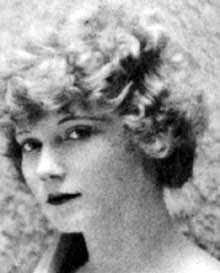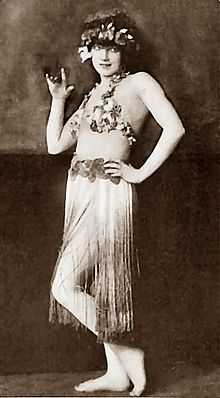Gilda Gray
| Gilda Gray | |
|---|---|
 | |
| Born |
Marianna Michalska October 24, 1901 Kraków, Poland |
| Died |
December 22, 1959 (aged 58) Los Angeles, California, U.S. |
Gilda Gray (October 24, 1901 – December 22, 1959) was a Polish actress and dancer who became famous in the U.S. for popularizing a dance called the "shimmy" which became fashionable in 1920s films and theater productions.
Early life and 'The Shimmy'
Gilda Gray was born as Marianna Michalska in Kraków, Austria-Hungary on 24 October 1901 to Max and Wanda Michalski, who emigrated to the United States in 1909 and settled in Milwaukee, Wisconsin. She had one sibling, Josephine.
When Marianna was 14 or 15 years old [citation needed] she married John Gorecki, a concert violinist (son of Socialist and union leader Martin Gorecki). The couple, who divorced in 1923, had one son, Martin Gorecki, who became a bandleader under the name Martin Gray. An obituary published in Time magazine reported that Gilda Gray was reportedly married at 11 and became a mother at 12.[1]
Although the shimmy is said to have been introduced to American audiences by Gray in New York in 1919, the term was widely used before. Some stories said that her shimmy was born one night when she was singing the Star Spangled Banner and forgot some of the lyrics. [citation needed] She covered up her embarrassment by shaking her shoulders and hips. Although the shimmy was already a well-known dance move, Marianna appropriated it as her own: when she was asked about her dancing style, she replied in a heavy Polish accent; "I'm shaking my chemise," which sounded to the English-speaking audience like shimmy. [citation needed]

Theatre Magazine, April, 1922
Career
Her desire to continue her burgeoning career (she used the professional name Mary Gray for a while) and her faltering relationship with her husband prompted her to relocate to Chicago where she was noticed by a talent agent, Frank Westphal, who took her to New York and introduced her to his wife, singer Sophie Tucker. It was Tucker who prompted her to change her first name to Gilda, a reference to her golden hair. [citation needed] By 1919, she was appearing in a J.J. Shubert show, The Gaieties of 1919. By 1920, Gilda had found a new manager, Gaillard T. "Gil" Boag (d. 1959). After being seen by Florenz Ziegfeld, she appeared in the 1922 Ziegfeld Follies where she was enormously popular with the public. [citation needed]
After her divorce from her first husband, in 1923 she married Gil Boag and took her successful vaudeville to Hollywood, California; they divorced four years later. She quickly abandoned vaudeville to become a film star, and between 1919 and 1936 Gray made several movies, in all of which she performed her famous shimmy. Her second role was a small part in Girl with the Jazz Heart. [citation needed]
Jesse Lasky signed her to a contract with Famous Players-Lasky, which released films through Paramount Pictures. With him she made Aloma of the South Seas (1926), which grossed $3,000,000 in its first three months. The success of this Paramount film was enhanced by Gilda's personal appearances doing the shimmy as a promotion. In 1927, she made two more films, The Devil Dancer and Cabaret.
1929 stock market crash
When the stock market crashed in 1929, Gilda Gray lost most of her financial assets, but she managed to get a job dancing at the Palace Theater in New York. She also appeared on stage in Cleveland, and became the subject for two very popular ceramic sculptures by Waylande Gregory, "The Nautch Dancer," and "The Burlesque Dancer".[2]
In future years she attempted comebacks but was hindered by poor health from regaining her status as a star. By now her second marriage had failed due to the stresses of financial problems complicated by her affair with her stage manager, Krepps. [citation needed]
Post-crash life
In 1931 she suffered a heart attack. In 1932, Gray announced her engagement to singer Art Jarrett, but abandoned their marriage plans when it became clear that the five-day waiting period between filing a marriage license and the actual ceremony could not be waived. [citation needed] On 23 May 1933, she married a Venezuelan diplomat, Hector Briceño de Saa. The couple separated two years later and divorced in 1938.
Polish patriot
During World War II, Gray worked for Poland including raising money.[3] In 1953, Ralph Edwards did her life story on his television show, This Is Your Life. He portrayed her courage in bringing six Polish citizens to America during the Cold War era. Gray also subsidized their education. She was decorated by Poland "for her interest and help to her countrymen and her country". [citation needed]
Death
By the time of her death at the age of 58 from a second heart attack, on December 22, 1959, Gilda Gray was again in financial trouble. [citation needed] According to an obituary published in The New York Times, she had lived there with Antonio Raio, a fire captain for Warner Brothers, and his wife for the past six years. Gray had suffered an attack of food poisoning five days prior to her death and was under the treatment of a physician. The Motion Picture Relief Fund paid for her funeral.
Filmography
- A Virtuous Vamp (1919) bit part
- Girl With the Jazz Heart (1923)
- Lawful Larceny (1925)
- Aloma of the South Seas (1926)
- Cabaret (1927)
- The Devil Dancer (1927)
- Piccadilly (1929)
- He Was Her Man (1929)
- The Great Ziegfeld (1936)
- Rose-Marie (1936)
Plays
- Music Box Revue (1921)
- Ziegfeld Follies (1922)
- Devil Dancer Play (1927)
Sources
- The Los Angeles Times, Shimmy Dancer Gilda Gray Dies, December 23, 1959, page 2.
- The New York Times, "Gilda Gray Dead on Coast at 58; Creator of Shimmy Was Singer", December 23, 1959, page 27.
References
- ↑ Time magazine obituary
- ↑ Folk, Thomas. Waylande Gregory: Art Deco Ceramics and the Atomic Impulse. Richmond, Virginia: University of Richmond Museums, 2013
- ↑ Biskupski, M.B.B. (2010) Hollywood's War With Poland 1939-1945 University Press of Kentucky ISBN 978-0-8131-2559-6 Page 12
External links
| Wikimedia Commons has media related to Gilda Gray. |
- Rare 50's TV appearance with Liberace:
- Gilda Gray at the Internet Movie Database
- Gilda Gray at Find a Grave
- Gilda Gray at the Dance History Archives
- Gilda Gray at Virtual History